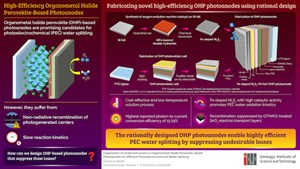News
Gwangju Institute of Science and Technology develops photoelectrodes for water splitting
H2 is mainly produced by natural gas, which, unfortunately, also generates greenhouse gases such as carbon dioxide as byproducts. Scientists argue that H2 produced this way, while economical, is not truly sustainable, and thus requires an eco-friendlier approach for its generation. Photoelectrochemical (PEC) water splitting based on solar energy is one such promising approach. However, its widespread application is limited by a lack of efficient photoanodes for catalyzing the rate-limiting oxygen evolution reaction (OER), an important reaction in PEC water splitting.

Recently, organometal halide perovskites (OHPs) have emerged as a promising photoanode material on this front. Unfortunately, OHP-based photoanodes suffer from two undesired losses that limit their efficiency. One is an internal loss resulting from a recombination of photogenerated charge carriers (required for electricity generation) within the anode itself, which, in turn, hinders water splitting. The other is external loss due to the slow reaction kinetics of water splitting, resulting in a loss of charge carriers at the interface of the anode and electrolyte.
Against this background, a team of researchers from Korea and U.S., led by Professor Sanghan Lee from Gwangju Institute of Science and Technology and including Associate Professor Jangwon Seo from Korea Advanced Institute of Science and Technology, has now developed a highly efficient OHP-based photoanode using a rational design approach, which overcomes the above limitations. Their study was published in the journal Advanced Energy Materials on June 17, 2023.
"The high efficiency of the photoanode for photoelectrochemical water splitting was achieved through the simultaneous suppression of internal and external losses of photogenerated carriers," highlighted Prof. Lee.
In their work, the team fabricated a novel Fe-doped Ni3S2/Ni foil/OHP photoanode in three steps. They first synthesized the Fe-doped Ni3S2 catalyst for OER on Ni foil through a hydrothermal method followed by a chemical conversion. They then separately fabricated the OHP photovoltaic cell consisting of SnO2 electron transport layers (ETLs) through spin coating. Finally, they combined the two components to obtain the photoanode.
The team found that adding glycidyltrimethylammonium chloride (GTMACl) to the anode passivated the defects at the OHP/ETL interface, effectively suppressing the undesired charge carrier recombination within the anode. Further, it enhanced the light-soaking stability of the OHP cell, a crucial factor in real-world PEC water splitting. Additionally, the high catalytic activity of Fe-doped Ni3S2 ensured a high OER rate at the anode, reducing the loss of photogenerated carriers within the electrolyte.
Consequently, the Fe-doped Ni3S2/Ni foil/OHP photoanode exhibited an unprecedented applied bias photon-to-current conversion efficiency of 12.79%, higher than that reported for OHP-based photoanodes in existing studies.
Overall, this study provides important insights into the prospects of rationally designed OHP-based photoelectrodes, as Prof. Lee said, "The proposed technology is expected to contribute to the vitalization of the H2 economy and carbon neutrality by enabling a large-scale and eco-friendly H2 production using solar energy without external voltage in the next 10 yr. This, in turn, will help realize H2 as an ideal renewable source of energy in the future."

